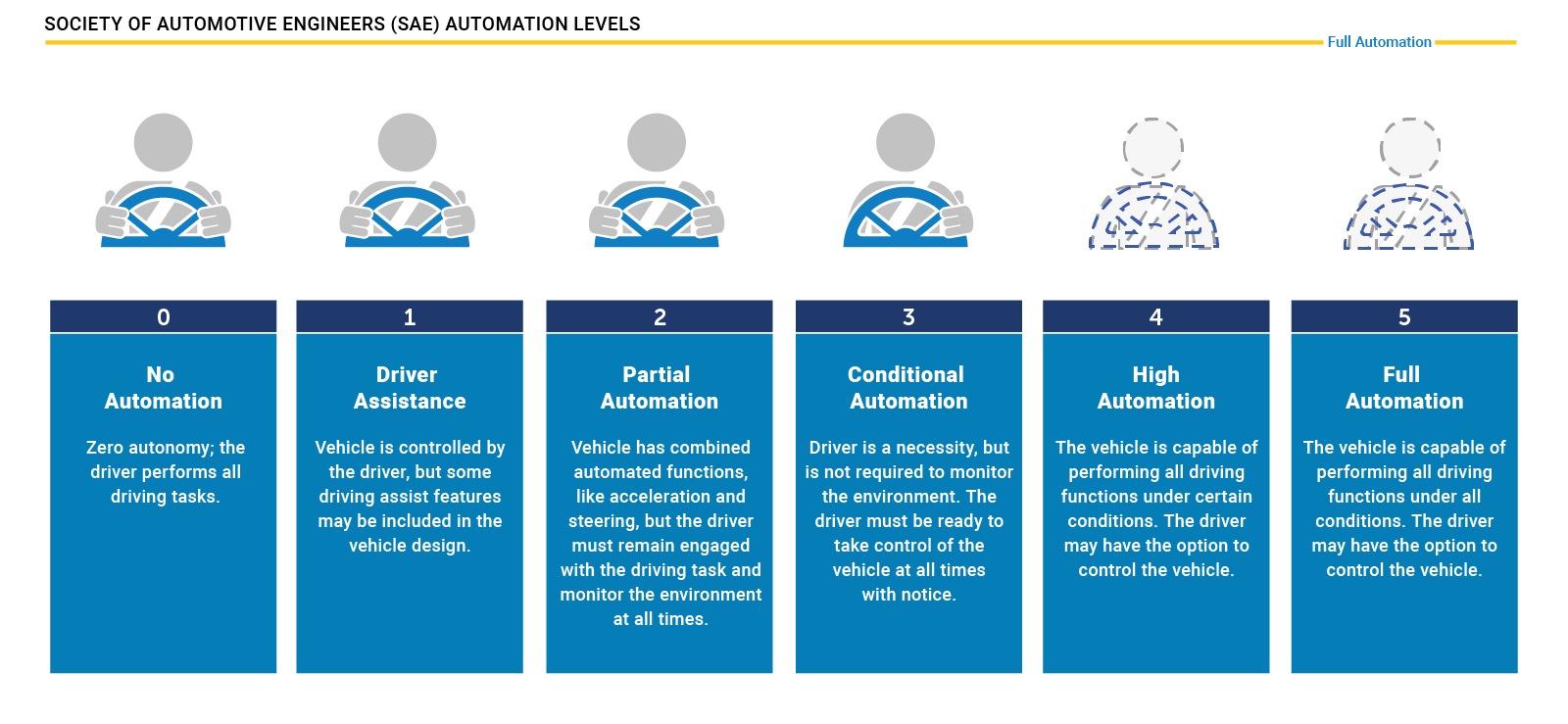The Evolution of Automated Safety Technologies
Driver assistance technologies in today’s motor vehicles are already helping to save lives and prevent injuries.
A number of today’s new motor vehicles have technology that helps drivers avoid drifting into adjacent lanes or making unsafe lane changes, or that warns drivers of other vehicles behind them when they are backing up, or that brakes automatically if a vehicle ahead of them stops or slows suddenly, among other things. These and other safety technologies use a combination of hardware (sensors, cameras, and radar) and software to help vehicles identify certain safety risks so they can warn the driver to act to avoid a crash.
The continuing evolution of automotive technology aims to deliver even greater safety benefits and – one day – deliver Automated Driving Systems (ADS) that can handle the whole task of driving when we don’t want to or can’t do it ourselves.
A Vision for Safety: Learn More
Download NHTSA’s voluntary guidance, technical documentation, and additional resources related to automated vehicles. Find out what’s included and what’s changed, and get answers to common questions.
Fully autonomous cars and trucks that drive us instead of us driving them will become a reality. These self-driving vehicles ultimately will integrate onto U.S. roadways by progressing through six levels of driver assistance technology advancements in the coming years. This includes everything from no automation (where a fully engaged driver is required at all times), to full autonomy (where an automated vehicle operates independently, without a human driver)..

Benefits
What does this mean for you as a driver?
| Levels of Automation | Who does what, when | |
|---|---|---|
| Level 0 | The human driver does all the driving. | |
| Level 1 | An advanced driver assistance system (ADAS) on the vehicle can sometimes assist the human driver with either steering or braking/accelerating, but not both simultaneously. | |
| Level 2 | An advanced driver assistance system (ADAS) on the vehicle can itself actually control both steering and braking/accelerating simultaneously under some circumstances. The human driver must continue to pay full attention (“monitor the driving environment”) at all times and perform the rest of the driving task. | |
| Level 3 | An Automated Driving System (ADS) on the vehicle can itself perform all aspects of the driving task under some circumstances. In those circumstances, the human driver must be ready to take back control at any time when the ADS requests the human driver to do so. In all other circumstances, the human driver performs the driving task. | |
| Level 4 | An Automated Driving System (ADS) on the vehicle can itself perform all driving tasks and monitor the driving environment – essentially, do all the driving – in certain circumstances. The human need not pay attention in those circumstances. | |
| Level 5 | An Automated Driving System (ADS) on the vehicle can do all the driving in all circumstances. The human occupants are just passengers and need never be involved in driving. | |
Benefits of Automation
Safety
The safety benefits of automated vehicles are paramount. Automated vehicles’ potential to save lives and reduce injuries is rooted in one critical and tragic fact: 94 percent of serious crashes are due to human error. Automated vehicles have the potential to remove human error from the crash equation, which will help protect drivers and passengers, as well as bicyclists and pedestrians. When you consider more than 35,092 people died in motor vehicle-related crashes in the U.S. in 2015, you begin to grasp the lifesaving benefits of driver assistance technologies.
Economic and Societal Benefits
Automated vehicles could deliver additional economic and additional societal benefits. A NHTSA study showed motor vehicle crashes in 2010 cost $242 billion in economic activity, including $57.6 billion in lost workplace productivity, and $594 billion due to loss of life and decreased quality of life due to injuries. Eliminating the vast majority of motor vehicle crashes could erase these costs.
Efficiency and Convenience
Roads filled with automated vehicles could also cooperate to smooth traffic flow and reduce traffic congestion. Americans spent an estimated 6.9 billion hours in traffic delays in 2014, cutting into time at work or with family, increasing fuel costs and vehicle emission. With automated vehicles, the time and money spent commuting could be put to better use. A recent study stated that automated vehicles could free up as much as 50 minutes each day that had previously been dedicated to driving.
Mobility
While its full societal benefits are difficult to project, the transformative potential of automated vehicles and their driver assistance features can also be understood by reviewing U.S. demographics and the communities these technologies could help to support.
For example, automated vehicles may also provide new mobility options to millions more Americans. Today there are 49 million Americans over age 65 and 53 million people have some form of disability.
In many places across the country employment or independent living rests on the ability to drive. Automated vehicles could extend that kind of freedom to millions more. One study suggests that automated vehicles could create new employment opportunities for approximately 2 million people with disabilities.
